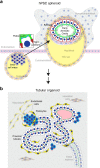Modelling kidney disease with CRISPR-mutant kidney organoids derived from human pluripotent epiblast spheroids
- PMID: 26493500
- PMCID: PMC4620584
- DOI: 10.1038/ncomms9715
Modelling kidney disease with CRISPR-mutant kidney organoids derived from human pluripotent epiblast spheroids
Abstract
Human-pluripotent-stem-cell-derived kidney cells (hPSC-KCs) have important potential for disease modelling and regeneration. Whether the hPSC-KCs can reconstitute tissue-specific phenotypes is currently unknown. Here we show that hPSC-KCs self-organize into kidney organoids that functionally recapitulate tissue-specific epithelial physiology, including disease phenotypes after genome editing. In three-dimensional cultures, epiblast-stage hPSCs form spheroids surrounding hollow, amniotic-like cavities. GSK3β inhibition differentiates spheroids into segmented, nephron-like kidney organoids containing cell populations with characteristics of proximal tubules, podocytes and endothelium. Tubules accumulate dextran and methotrexate transport cargoes, and express kidney injury molecule-1 after nephrotoxic chemical injury. CRISPR/Cas9 knockout of podocalyxin causes junctional organization defects in podocyte-like cells. Knockout of the polycystic kidney disease genes PKD1 or PKD2 induces cyst formation from kidney tubules. All of these functional phenotypes are distinct from effects in epiblast spheroids, indicating that they are tissue specific. Our findings establish a reproducible, versatile three-dimensional framework for human epithelial disease modelling and regenerative medicine applications.
Conflict of interest statement
J.V.B. holds patents on KIM-1 entitled ‘Kidney injury-related molecules', patent number US6664385. The rights have been assigned to Partners Healthcare. The remaining authors declare no competing financial interests.
Figures








Comment in
-
Development: Modelling disease in kidney organoids.Nat Rev Nephrol. 2016 Jan;12(1):4. doi: 10.1038/nrneph.2015.181. Epub 2015 Nov 10. Nat Rev Nephrol. 2016. PMID: 26553516 No abstract available.
References
-
- Steiner D. et al.. Derivation, propagation and controlled differentiation of human embryonic stem cells in suspension. Nat. Biotechnol. 28, 361–364 (2010). - PubMed
-
- Takahashi K. et al.. Induction of pluripotent stem cells from adult human fibroblasts by defined factors. Cell 131, 861–872 (2007). - PubMed
Publication types
MeSH terms
Substances
Grants and funding
- MOP-84545/CAPMC/ CIHR/Canada
- K01 DK102826/DK/NIDDK NIH HHS/United States
- DK072381/DK/NIDDK NIH HHS/United States
- K01 DK099473/DK/NIDDK NIH HHS/United States
- R01 DK051050/DK/NIDDK NIH HHS/United States
- DK51050/DK/NIDDK NIH HHS/United States
- R37 DK039773/DK/NIDDK NIH HHS/United States
- DK102826/DK/NIDDK NIH HHS/United States
- F32 DK092036/DK/NIDDK NIH HHS/United States
- R01 DK099532/DK/NIDDK NIH HHS/United States
- R25 DK101398/DK/NIDDK NIH HHS/United States
- DK092036/DK/NIDDK NIH HHS/United States
- DK864406/DK/NIDDK NIH HHS/United States
- R01 DK039773/DK/NIDDK NIH HHS/United States
- R37 DK051050/DK/NIDDK NIH HHS/United States
- R01 DK072381/DK/NIDDK NIH HHS/United States
- DK39773/DK/NIDDK NIH HHS/United States
- DK099532/DK/NIDDK NIH HHS/United States
- K08 DK089002/DK/NIDDK NIH HHS/United States
LinkOut - more resources
Full Text Sources
Other Literature Sources
Medical
Research Materials
Miscellaneous

